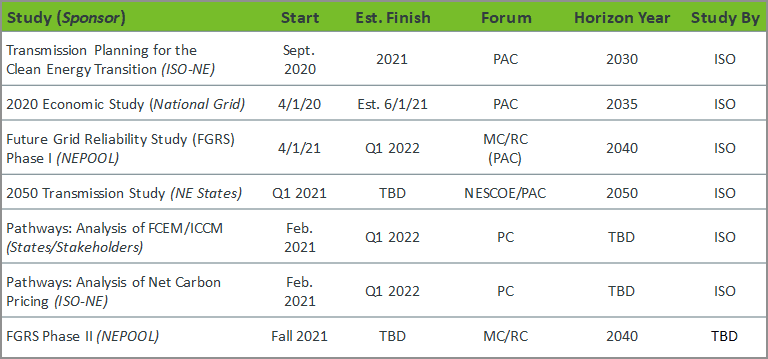New England Future Grid Initiative: February 2021 update

ISO New England and regional stakeholders have been collaborating to assess and explore potential market and reliability issues that may arise in the coming years as the electric industry experiences significant change driven by rapid innovation and state energy and environmental policies to incentivize economy-wide decarbonization. The most recent regional effort, known as the New England Future Grid Initiative, consists of two primary tracks: the Future Grid Reliability Study (“Reliability Study”) and the Pathways to the Future Grid Analysis (“Pathways Analysis”).
ISO New England’s approach to the New England Future Grid Initiative was last discussed in a presentation by ISO Executive Vice President and COO Vamsi Chadalavada during the February 18, 2021 New England Power Pool (NEPOOL) Participants Committee Meeting (NPC).
Future Grid Reliability Study
The Reliability Study is an analysis, based on stakeholder-defined scenarios and assumptions, to identify potential gaps that could arise in the future power system. The assumptions, which are at the heart of the study, were created through stakeholder discussions at the NEPOOL Markets Committee and Reliability Committee, which includes the active participation of various state entities.
Through these discussions, stakeholders developed a Framework Document and supporting assumption tables that are comprised of twenty-four potential future scenarios in the 2040 timeframe. These scenarios will be studied by ISO New England staff and outside experts to better understand the implications of a future grid where renewable penetration is high and demand profiles are dramatically different than today.
ISO New England anticipates commencing phase one of these studies in March 2021 and completing these studies by the first quarter of 2022. Phase one studies will include:
- A Production Cost Simulation that will model resource dispatch and energy market revenues for different scenarios;
- An Ancillary Services Simulation that will model if the necessary amounts of reserves, ramping, and load following resource are available to operate the system reliably under the scenarios;
- A Resource Adequacy Screening that will determine the Installed Capacity Requirement for each future scenario and ensure that reliability standards are met; and
- A Probabilistic Resource Availability Analysis that will analyze periods outside system peak conditions when reliability standards may not be met under the proposed scenarios.
Stakeholders are also discussing an additional series of studies (phase two) to assess revenue sufficiency and system security. The ISO recently suggested that stakeholders pause on these phase two studies for the time being in order to focus on the phase one studies. The results of the phase one studies and other ongoing studies, such as a similar study recently requested by the states, will be critical inputs into the phase two studies. Moreover, the ISO believes it would be more effective for the region if related issues can first be further refined or resolved before dedicating a significant amount of resources for the additional analyses.
For example, how the Minimum Offer Price Rule (MOPR), a forward capacity market rule that requires sponsored resources to bid at their unsubsidized cost, is treated in modeling assumptions will be central to the phase two analysis. The Federal Energy Regulatory Commission (FERC) recently stated addressing the MOPR is a top priority for the commission in the near term.
Pathways to the Future Grid
The Pathways Analysis is a regional stakeholder effort to identify, explore, and evaluate potential alternative market concepts (“pathways”) that may help support the evolution of the region’s power grid. After robust discussions during the summer of 2020 at the NPC, Dr. Frank Felder, a Rutgers University professor hired by NEPOOL to conduct a high-level evaluation of the various tradeoffs associated with the identified pathways, released his report in January 2021.
The report provides observations about each potential pathway and evaluates whether the various approaches could help to advance the states’ clean energy policy objectives and whether the design promotes market efficiency. Pathways evaluated in the report include a Forward Clean Energy Market (“FCEM”), an Integrated Clean Carbon Market (“ICCM”), A Carbon Pricing mechanism, an Energy-Only Market, and several Alternative Reliability Assurance Frameworks.
ISO New England’s Board of Directors has directed ISO management to further evaluate the concepts of net carbon pricing and a FCEM. ISO plans to begin this analysis, with the assistance of an outside consultant, in February 2021, with a final report targeted for February 2022. Stakeholders began discussing parameters for evaluating these conceptual designs at the February 18 NPC.
More information on the Reliability Study and Pathways Analysis, including recent presentations and reports, can be found on the ISO’s website dedicated to New England’s Future Grid Initiative.
The following chart provides details about the ongoing studies the ISO is carrying out, in addition to its regularly planned studies that look to identify evolving conditions on the power system. This chart was presented at the February 18, 2021 NPC meeting.
2021 Future Grid Studies

Additional Ongoing Transmission Planning Studies
In addition to the Reliability Study and Pathways Analysis detailed above, ISO staff is working collaboratively with stakeholders on two additional transmission studies. These studies, entitled Transmission Planning for the Clean Energy Transition and 2050 Transmission Study, are intended to better align regional system planning efforts with state policy goals.
Transmission Planning for the Clean Energy Transition is a pilot study to analyze operational issues and constraints that may arise on a future grid with significantly greater amounts of distributed energy resources, a greater amount of renewables, and different operational characteristics than today’s grid. The study was prompted by trends in New England that the ISO anticipates will accelerate in the future, including shifting demand, rapid DER and renewable development, and increased HVDC imports. This study is currently being discussed and refined at ISO’s Planning Advisory Committee (PAC), the ISO’s public stakeholder forum for providing input and feedback on regional system planning efforts. To date, ISO staff have presented base cases and assumptions to the PAC and have sought feedback from stakeholders. All materials related to the Transmission Planning for the Clean Energy Transition study are located on the PAC website.
ISO New England is initiating the 2050 Transmission Study in support of the New England States Committee on Electricity’s (NESCOE) recent Vision Statement, which highlighted the importance of a transmission planning process that helps to inform all stakeholders of the amount and type of transmission infrastructure that is needed to cost-effectively integrate clean energy resources and DERs across the region. The ISO anticipates providing periodic study updates to the PAC going forward.
- Categories
- Industry News & Developments
- Tags
- future grid, new england states, transmission planning



